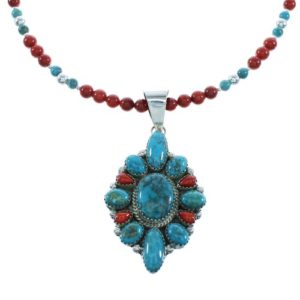
Fire and ice are the most beautiful of all combinations because of their duality in nature. This concept and design has withstood the test of time for generations and frequently appears in both fashion and history. One of the most common examples of this phenomenon is the use of coral and turquoise necklaces and other jewelry.
Some of the most prevalent users of this combination are the Native American tribes of the Southwest. Because turquoise mines are so abundant in this area and because trading was so rich among tribes, the use of turquoise and coral in jewelry was quite popular among both Native Americans and, much later, by the general public.
Although both stones get the origins from water, with different compositions, these stones are formed in completely different ways.
Turquoise is formed in a cave and made when water flows through the cave and carries certain minerals through the deposit, taking millions of years. Coral, on the other hand, forms much more organically by sea life, made primarily from a high concentration of calcium carbonate from the once living sea-organism.
Both are shaped and given by life but have drastically different outcomes. The creation of coral and turquoise necklaces became popular when Native American tribes started trading with American settlers.
Making coral and turquoise necklaces take great skill, especially when setting these two different stones into a sterling silver setting. The delicate nature of untreated turquoise or coral takes a very talented hand to transform into a durable piece of art.
The history of coral and turquoise necklaces expands over centuries and continues to be a beautiful and inspiring way of relating culture and tradition for Native American artisans. The style has become so popular in recent years that many Native artists are taking to more contemporary styles as well.
